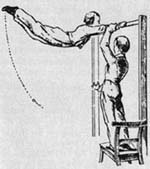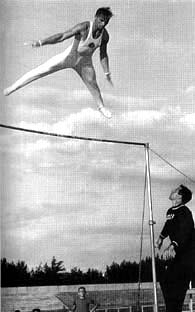|
|
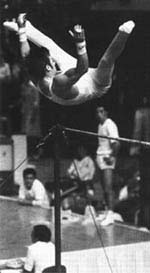
Bernd Jäger
(FRG)
|
|
To increase performances through improvement of elasticity
was an idea not thought about before the WW I. In German
gymnastics this happened not before the start of the
sportive, that means Olympic and international artistic
gymnastics during the preparation for the Olympic Games
1936 through the Olympic candidates Ernst
Winter (Frankfurt/Main) and Richard
Reuther (Oppau). But one should not imganine these constructions
as being too stiff: Already at the Olympic Games 1908
in London a gymnast performed a double somersaulto,
even though after plety of giants backwards!
Alexander
Tkatschew's
(URS) counter-straddle of '77
|
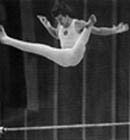
|
Alberto
Braglia from Italy, the world's best gymnast
of his time, also performed on a good apparatus in Stockholm
1912, on which he could show his highly admired artistic gymnastics.
Firstly, the tightening had not been at the height of
the variable bar, but later the pilar was integrated into the
springs process.
<<<With the Jäger-somersault the development of flying
elements on high bar started in 1974
|
For, so Richard
Reuther who was representing the German Gymnastics
Federation in the committee of norms, in the year 1953:
"It has to be of that kind that
the elasticity of the whole body can be used unhinderingly on
the apparatus, without getting damaged. The apparatus must be
constructed in a way that it forces the gymnast to perform with
dynamic style. It has to form an elastic springing unity in
its coplete construction, in which the more antipowers are caused,
the more powers are comming to effect from outside."
Eberhard
Gienger >>>
The World Champion of '78 is
the inventor of the popular Gienger-Saltos ('77)
For
the development of the "flying" on high bar the invention
of the Bulgarian Stojan Deltschew was essential, too. Actually,
his straddle somersault forwards with 1/2 turn was the origin
for Gienger. "Somehow I did not manage this thing, the
Deltschew-somersault, and suddenly my own version was created!",
so Gienger.
|
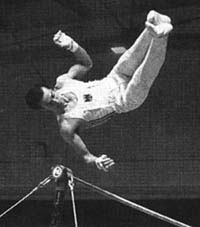
|
In the "Norms
of apparatuses" of 1979 still some things were
changed to adjust the apparatus for further developments. This efects
especially the height of the Horizontal Bar and therefore also the change
of the (double-)fixation. From 1906 to 1965 the high bar had a maximum
height of 2,550 mm, now the maximum height was 2,750 mm with 5
mm tolerance. From now on a long gymnast could execute his routine despite
thicker floor mats under the bar, that had become very important becasue
of new flying elements -as well as a shorter gymnast on the normal horizontal
bar with a height of 2,550 mm. The following rule was prescribed for
the safety of the gymnast: "The bar has to endure at least
the 8-fold body weight of a gymnast performing in the middle of the
bar and is not supposed to break or bend."
|
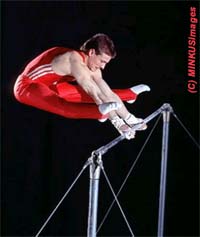
Ralph Büchner
Gymnastics on high bar on highest level - the
World Champion of '91
|
The
Horizontal Bar has a long and developed history
and each part has its own one.
First, everything served for a better handling and a higher
safety, then especially for increasing top performances when
gymnastics became a high performance sport. Let it be, that
an ingenious gymnast performed exercises that could not be done
by others on the existing apparatuses, or that coaches, gymnasts
and engineers opened the way with help of new constructions
for even more bold swings and flights, of which many people
think that they are the finishing chapter of artistic gymnastics
on high bar:
Jari
Tanskanen
>>>
The surprise World Champion in Lausanne 1997
on the 'king of apparatuses'
|
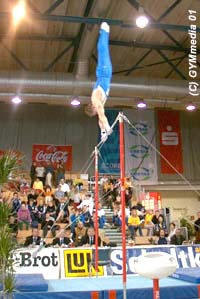 |
|
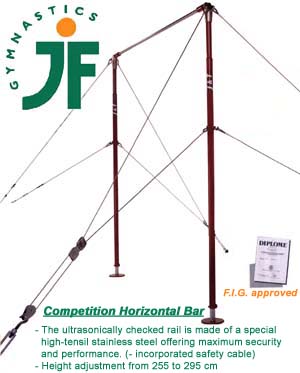
|
Jäger-somersault,
Deltschew-somersault, Tkatschew-straddle, Gienger-, Gaylord-,
Kovacs-somersault - in the mean time even with
additional twists as the Non-Plus-Ultra of modern gymnastics
- these elements require constructions of the most modern kind.
Only excellent qualities of the material enable gymnastics on
high bar that corresponds with the dynamic of human movements.
Hereby, the co-ordination of the quality of the bar, the pilars
and the tightening is essential.
Free flights with
or without turns of 360° to re-grip the bar demand a techical
perfercted apparatus.
Janssen&Fritsen offers the
athletes of the 35th world championships in Belgique Ghent
such a harmonic construction, that is called legitimately
the "king of apparatuses".
|
|
Created and translated
by:
Florian Schmid-Sorg
|
|
Sources/Quellen:
"Der Vorturner", 1927/28; "Das Turnjahrhundert
der Deutschen", Götze/Herholz: Beckmanns Sportlexikon
A-Z, Leipzig, Wien 1933; "Geschichte der Turngeräte",
J. Göhler/R. Spieth; "Mondsalto", gymbooks Verlag
1994, A. Götze/J. Uhr; "FlickFlack...", Sportverlag
Berlin, A .Götze/H.-J. Zeume; "The History of British
Gymnastics", 1988 by BAGA; Katalog J&F
|
|
|
|

